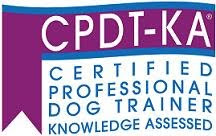Debunking Dominance and Leadership for your Dog
By: Laura Chapman, Miss Behavior
For decades, the idea of dominance and dependence on establishing yourself as the alpha by forcing dogs in submission through alpha rolls, choke collars, and other aggressive methods has existed. With this mentality, there is an assumption whenever a dog does something inappropriate, whether pulling on leash, jumping on people, or going through the door first, that the dog is trying to prove his rank. In more recent years, with the emergence of popular television shows focusing on these dog training methods, this theory has erupted into the homes of dogs everywhere and despite the disclaimers and advice to consult a professional, everyone is trying bits and pieces of these methods without looking at the big picture. Let’s look at the definition of dominance.


Dominance is defined as a relationship between individual animals that is established by force/aggression and submission, to determine who has priority access to multiple resources such as food, preferred resting spots, and mates. A dominant-submissive relationship does not exist until one party consistently submits or defers. The problem with the dog-guardian population is that most issues that come up with our companion dogs are not related to priority access of a resource. Jumping on people, pulling on the leash, and running through the door first are not about access to resources but rather about something that has been reinforced in the past or something that the dog has not been taught not to do. Remember that dogs do what works. If you stay in that mindset, you can change a lot of your dog’s behaviors.
Let’s look at leash pulling as an example. Dogs pull on leash because it works. It gets them to where they want to go and it’s usually the fastest way of getting there. We follow. They see another dog and try to pull you all the way there and you follow. What’s the reward? Seeing, sniffing, and maybe playing with the other dog. It’s not about them plotting your demise and trying to be your alpha. It’s about the fact that we have allowed the pulling or not taught them otherwise. For a lot of dogs, pulling also feels good so it’s very self-rewarding. It gives them the exercise they may otherwise not be getting, and dogs are built with a reflex (the opposition reflex) in which they brace or pull against your pressure, the very reason why harnesses often cause more pulling.
Using this mentality, let’s look at jumping on people. Again, they are not plotting their demise and thinking to themselves “ooo, there is a new person coming in the house – watch this, I will jump on her and show her who’s boss!”. No, rather it’s something that has been rewarded in the past so it continues. The dog jumps, the stranger coming in the house inadvertently rewards it but saying “oh, its ok, I don’t mind”, pets the dog or pushes him off (also rewarding), and the cycle continues. And, like pulling on leash, a lot of dogs enjoy jumping.
Remember that age-old adage that aggression begets aggression. Using aggressive tendencies to show your dog who’s boss, such as rolling him on his back, yelling at him, getting in his face, depending on a pinch, choke collar, or e-collar to make your message clear… that’s not good leadership. However, it is a great way to make your dog more frustrated, more fearful, and possibly more aggressive.
Good leadership is clear and consistent. There are clear rules and boundaries. It is non-confrontational. Think about a good boss at work. It’s not the in-your-face type. It’s the type that gives you enough freedom to use your skills and personality as an asset to the company while also giving you those clear and consistent rules and boundaries to follow. Think about a good parent. It’s the same idea. There should be consequences for inappropriate behavior, but the consequences do not need to be physical. The rules should be consistent. You should have fun, and laugh, and play too. Create a positive bond, rather than using intimidation tactics. Work with and not against personality types, accepting your children (whether 2 or 4-legged) for who they are.
Most importantly, if you are having behavior problems with your dogs, consult a professional. Seek help from someone who works on behalf of your dog and teaches you how to find that common ground.








